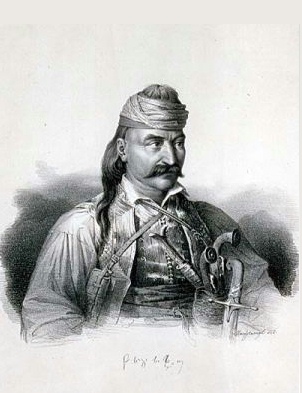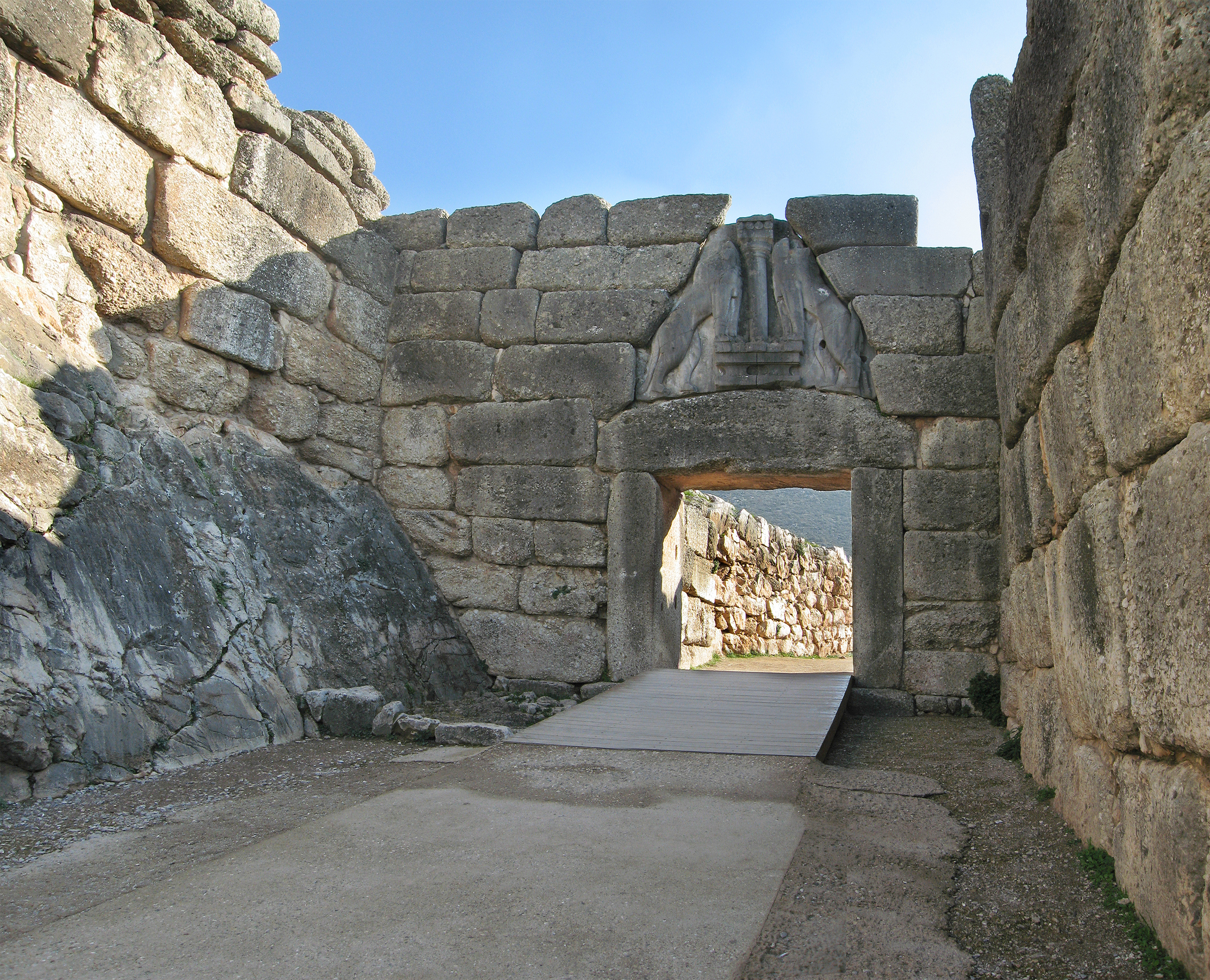|
Agios Vasileios, Corinthia
Agios Vasileios ( meaning Saint Basil) is a village in the municipal unit of Tenea in Corinthia, Greece. It is located about 25 km to the south of the city of Corinth, approximately halfway along the old national road to Argos ( GR-7). It lies at the foot of the Dafnias mountains and the Chouni Pass. Historical population Historical overview Prehistory Archaeological excavations prove that the area around Agios Vasilios has been settled since pre-historical times. Zygouries, west of Agios Vasilios, was excavated by the American archaeologist Carl William Blegen in the 1920s. He found a Bronze Age settlement dating from approximately 1300 BC to 1320 BC. Sadly, agricultural work and forestry on Zygouries hill has destroyed one of the most important pre-historical settlements of the Balkans. Obsidian, sherds of which can be found over the whole area (particularly south of Agios Sostis (the cave of Antonis in the area of Boubakia), in the Chouni Pass southwest of the vil ... [...More Info...] [...Related Items...] OR: [Wikipedia] [Google] [Baidu] |
Peloponnese (region)
The Peloponnese Region (, ) is a region in southern Greece. It borders Western Greece to the north and Attica to the north-east. The region has an area of about . It covers most of the Peloponnese peninsula, except for the northwestern subregions of Achaea and Elis which belong to Western Greece and a small portion of the Argolid peninsula that is part of Attica. Administration The Peloponnese Region was established in the 1987 administrative reform. With the 2011 Kallikratis plan, its powers and authority were redefined and extended. Along with the Western Greece and Ionian Islands regions, it is supervised by the Decentralized Administration of Peloponnese, Western Greece and the Ionian Islands based at Patras. The region is based at Tripoli and is divided into five regional units (pre-Kallikratis prefectures), * Arcadia, * Argolis, * Corinthia, * Laconia and * Messenia, which are further subdivided into 26 municipalities. The largest city of the ... [...More Info...] [...Related Items...] OR: [Wikipedia] [Google] [Baidu] |
Aqueduct (Roman)
The Romans constructed aqueducts throughout their Republic and later Empire, to bring water from outside sources into cities and towns. Aqueduct water supplied public baths, latrines, fountains, and private households; it also supported mining operations, milling, farms, and gardens. Aqueducts moved water through gravity alone, along a slight overall downward gradient within conduits of stone, brick, concrete or lead; the steeper the gradient, the faster the flow. Most conduits were buried beneath the ground and followed the contours of the terrain; obstructing peaks were circumvented or, less often, tunneled through. Where valleys or lowlands intervened, the conduit was carried on bridgework, or its contents fed into high-pressure lead, ceramic, or stone pipes and siphoned across. Most aqueduct systems included sedimentation tanks, which helped to reduce any water-borne debris. Sluices, ''castella aquae'' (distribution tanks) and stopcocks regulated the supply to individu ... [...More Info...] [...Related Items...] OR: [Wikipedia] [Google] [Baidu] |
Theodoros Kolokotronis
Theodoros Kolokotronis (; 3 April 1770 – ) was a Greek general and the pre-eminent leader of the Greek War of Independence (1821–1829) against the Ottoman Empire. The son of a klepht leader who fought the Ottomans during the Orlov revolt, Kolokotronis also operated as a klepht and an armatolos early in his life. While serving in the British army during the Napoleonic Wars, he became influenced by the revolutionary ideas of the era. On the outbreak of the Greek War of Independence, he organized a band of Moreot klephts and captured Tripolitsa in late 1821. Kolokotronis achieved his greatest success at the 1822 Battle of Dervenakia, where he routed the Ottoman forces under the command of Mahmud Dramali Pasha. From 1823 to 1825, he took part in the Greek civil wars and, following the defeat of his faction, he was briefly imprisoned in Hydra. In 1825, Kolokotronis was released and appointed commander-in-chief of the Greek forces in Peloponnese. He defended Greece agains ... [...More Info...] [...Related Items...] OR: [Wikipedia] [Google] [Baidu] |
Ottoman Empire
The Ottoman Empire (), also called the Turkish Empire, was an empire, imperial realm that controlled much of Southeast Europe, West Asia, and North Africa from the 14th to early 20th centuries; it also controlled parts of southeastern Central Europe, between the early 16th and early 18th centuries. The empire emerged from a Anatolian beyliks, ''beylik'', or principality, founded in northwestern Anatolia in by the Turkoman (ethnonym), Turkoman tribal leader Osman I. His successors Ottoman wars in Europe, conquered much of Anatolia and expanded into the Balkans by the mid-14th century, transforming their petty kingdom into a transcontinental empire. The Ottomans ended the Byzantine Empire with the Fall of Constantinople, conquest of Constantinople in 1453 by Mehmed II. With its capital at History of Istanbul#Ottoman Empire, Constantinople (modern-day Istanbul) and control over a significant portion of the Mediterranean Basin, the Ottoman Empire was at the centre of interacti ... [...More Info...] [...Related Items...] OR: [Wikipedia] [Google] [Baidu] |
Dervenakia
Dervenakia () is a small village in Corinthia, in northeastern Peloponnese (southern Greece). It is situated on the old Greek_National_Road_7, national highway from Nafplio to Corinth. Dervenakia is part of the community of Archaia Nemea. The name is derived from the Ottoman Turkish language, Ottoman Turkish word ''dervent'' (:wikt:دربند, دربند), meaning mountain pass. The place is famous for the Battle of Dervenakia, fought on 26–28 July 1822 during the Greek War of Independence, where 2,300 Greek irregulars under Theodoros Kolokotronis defeated the 30,000-strong army of Ottoman general Mahmud Dramali Pasha. Populated places in Corinthia {{Peloponnese-geo-stub ... [...More Info...] [...Related Items...] OR: [Wikipedia] [Google] [Baidu] |
Venice
Venice ( ; ; , formerly ) is a city in northeastern Italy and the capital of the Veneto Regions of Italy, region. It is built on a group of 118 islands that are separated by expanses of open water and by canals; portions of the city are linked by 438 bridges. The islands are in the shallow Venetian Lagoon, an enclosed bay lying between the mouths of the Po River, Po and the Piave River, Piave rivers (more exactly between the Brenta (river), Brenta and the Sile (river), Sile). As of 2025, 249,466 people resided in greater Venice or the Comune of Venice, of whom about 51,000 live in the historical island city of Venice (''centro storico'') and the rest on the mainland (''terraferma''). Together with the cities of Padua, Italy, Padua and Treviso, Italy, Treviso, Venice is included in the Padua-Treviso-Venice Metropolitan Area (PATREVE), which is considered a statistical metropolitan area, with a total population of 2.6 million. The name is derived from the ancient Adr ... [...More Info...] [...Related Items...] OR: [Wikipedia] [Google] [Baidu] |
Principality Of Achaea
The Principality of Achaea () or Principality of Morea was one of the vassal states of the Latin Empire, which replaced the Byzantine Empire after the capture of Constantinople during the Fourth Crusade. It became a vassal of the Kingdom of Thessalonica, along with the Duchy of Athens, until Thessalonica was captured by Despotate of Epirus, Epirus in 1224. After this, Achaea became the dominant power in Greece, lasting continuously for 227 years and cumulatively for 229. Foundation Achaea was founded in 1205 by William of Champlitte and Geoffrey I of Villehardouin, who undertook to conquer the Peloponnese on behalf of Boniface I, Marquis of Montferrat, Boniface of Montferrat, Kingdom of Thessalonica, King of Thessalonica. With a force of no more than 100 knights and 500 foot soldiers, they took Achaea and Medieval Elis, Elis, and after defeating the local Greeks in the Battle of the Olive Grove of Koundouros, they became masters of the Morea. The victory was decisive, and after t ... [...More Info...] [...Related Items...] OR: [Wikipedia] [Google] [Baidu] |
Acciaioli
The Acciaioli family, also spelled Acciaiuoli, Accioly, Aciole, Acciajuoli or Acioli was an important Italian nobility, Italian noble family from Florence, whose members were the ruling Duchy of Athens, Dukes of Athens. History Family name is also written Acciaioli, Acciainoli, or Accioly, Accioli, Aciole, Acioli and Acyoly in Portugal and Brazil, where there are branches of it. Descent can be traced in an unbroken line from one Gugliarello Acciaioli in the 12th century; family legend says that Gugliarello (a name possibly derived from It. ''guglia'', needle) migrated from Brescia to Florence in 1160 because they were House of Welf, Guelphs and fled Frederick I, Holy Roman Emperor, Barbarossa's invasion of Northern Italy. The Acciaioli founded a powerful bank in the 13th century (Compagna di Ser Leone degli Acciaioli e de' suoi consorti) which had branches from Greece to Western Europe until the bank collapsed in 1345.Jace Stuckey, ''The Eastern Mediterranean Frontier of Latin ... [...More Info...] [...Related Items...] OR: [Wikipedia] [Google] [Baidu] |
Mycenaean Period
Mycenaean Greece (or the Mycenaean civilization) was the last phase of the Bronze Age in ancient Greece, spanning the period from approximately 1750 to 1050 BC.. It represents the first advanced and distinctively Greek civilization in mainland Greece with its palatial states, urban organization, works of art, and writing system.. The Mycenaeans were mainland Greek peoples who were likely stimulated by their contact with insular Minoan Crete and other Mediterranean cultures to develop a more sophisticated sociopolitical culture of their own. The most prominent site was Mycenae, after which the culture of this era is named. Other centers of power that emerged included Pylos, Tiryns, and Midea in the Peloponnese, Orchomenos, Thebes, and Athens in Central Greece, and Iolcos in Thessaly. Mycenaean settlements also appeared in Epirus, Macedonia, on islands in the Aegean Sea, on the south-west coast of Asia Minor, and on Cyprus, while Mycenaean-influenced settlements appeare ... [...More Info...] [...Related Items...] OR: [Wikipedia] [Google] [Baidu] |
Franks
file:Frankish arms.JPG, Aristocratic Frankish burial items from the Merovingian dynasty The Franks ( or ; ; ) were originally a group of Germanic peoples who lived near the Rhine river, Rhine-river military border of Germania Inferior, which was the most northerly province of the Roman Empire in continental Europe. These Frankish tribes lived for centuries under varying degrees of Roman hegemony and influence, but after the collapse of Roman institutions in western Europe they took control of a large empire including areas which had been ruled by Rome, and what it meant to be a Frank began to evolve. Once they were deeply established in Gaul, the Franks became a multilingual, Catholic Christian people, who subsequently came to rule over several other post-Roman kingdoms both inside and outside the old empire. In a broader sense much of the population of western Europe could eventually described as Franks in some contexts. The term "Frank" itself first appeared in the third cent ... [...More Info...] [...Related Items...] OR: [Wikipedia] [Google] [Baidu] |





